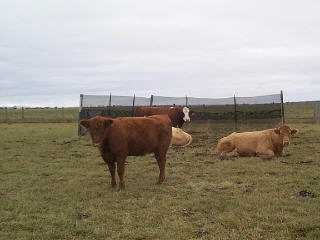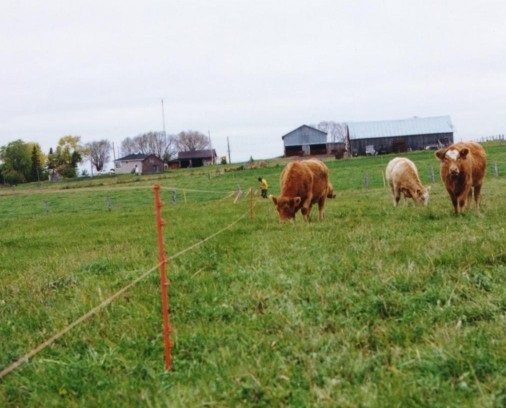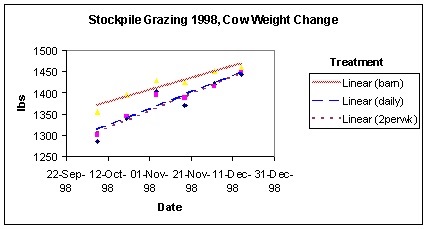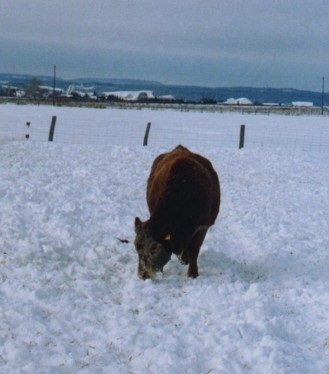Stockpiling to lengthen the beef cow grazing season
Research results from a study to extend the beef cow grazing season.
Cattle on pasture... picture it... warm temperatures, contented cows grazing lush green forage... and lots less work than feeding during the winter! Wouldn't it be nice if our cows could graze most of the year? Some recent projects at the New Liskeard Agricultural Research Station of the University of Guelph have shown that we may be able to significantly extend the grazing season in an area with a humid, temperate climate. Using the technique of "stockpiling", with common perennial forages, the grazing season has been extended into mid December. During the initial two years of this project at NLARS, the grazing season for dry pregnant beef cows was extended by about 70 days.
Stockpiling refers to the practice whereby a forage stand is harvested (by animal or machine) in mid summer, and then allowed to regrow into the fall season. After grazing on conventionally managed pastures is finished, cattle are turned into the stockpiled standing forage. Ideally, grazing of the stockpile commences after a killing frost has eliminated the potential for forage regrowth. This minimizes the stress on plants which would be caused by diminishing root energy reserves prior to winter dormancy.
The main objective of this management practice is to maximize the number of days that cattle are able to continue grazing. This cuts costs, since it is less expensive to have the animals do their own forage harvesting and manure spreading, rather than doing it for them... cutting, baling, hauling and feeding hay takes time and fuel as well as wearing out machinery. Likewise, bedding used in confinement situations represents costs both on the supply side and disposal side.
Under the direction of Project Leader Dr. Jock Buchanan-Smith, of the University of Guelph, stockpile grazing trials with beef cows were initiated at New Liskeard in 1997. We wanted to determine the feasibility of using stockpiled perennial forages for grazing dry, pregnant beef cows grazing in late fall and early winter.
The 1997 trial was part of the research program of University of Guelph Animal Science graduate student Christoph Wand. The 60 beef cows in the study were all dry, and in the middle trimester of pregnancy. Younger cows were predominately Angus X Continental, while older cows were mostly Continental crosses. A conventionally managed control group consisting of two pens of 10 cows each were housed in a naturally ventilated barn and fed round baled hay. The 40 pasture cows were divided into 4 groups of 10, each on a 12.5 acre paddock. Two groups were on a predominately grass pasture (timothy, orchard grass and quack grass) while the other 2 were on a legume/grass pasture (trefoil, white clover plus grasses). Pasture animals had access an L-shaped plastic mesh windbreak in each paddock. Water was provided on pasture via energy free insulated water bowls fed by trenched-in water lines. Pasture forage was allocated by strip grazing - a polywire fence was moved forward on a daily basis to allow maximum intake while limiting waste due to trampling. A back fence was not used, so the area accessible to the cows increased over time as the lead fence was moved down the field.
Windbreak and cows
The animals were weighed, and scored for body condition every two weeks. Cows grazed the stockpiled forage from October 3. to December 18. When compared over the entire time period, the grazing cows and barn cows had similar increases in body weight and back fat. During the last 3 weeks of the trial, the pasture groups experienced some weight loss, although the degree of weight loss was not considered to be detrimental to animal health. All animals were monitored through the subsequent calving season and rebreeding period. There were no differences between the stockpile or barn managed groups for birth weight, calving ease or pregnancy rate.
Building on these results, a subsequent trial was implemented in the same paddocks in 1998, with cows from the same herd. Since daily fence movement is labour intensive, and not particularly enjoyable during brisk days in November and December, we wanted to evaluate the effect of moving the polywire fence only twice per week, relative to the daily routine. If the less intensive regime gave acceptable animal performance and forage utilization, it should improve the interest level of farmers in utilizing this management strategy. Since stockpile regrowth was reduced by about 20% relative to 1997, due a late summer dry spell, stocking rates were reduced to 8 cows in each of the 4 paddocks. The barn control group was maintained at 20 head.
Grazing in October
What did we find? After adjusting for variations in start of trial back fat, there was no difference for weight gain between the daily or twice-weekly moved pasture groups (see chart 1). Over the 69 day trial period, the daily move group averaged 137 lbs of weight gain, while the twice per week group averaged 142 lbs of gain. These compared favourably with the performance of the barn cows, which averaged 120 lbs of weight gain. Statistical analysis revealed that the cows moved twice per week had a significantly higher (p < .05) weight gain than the barn cows. Based on ultrasonic measurements taken at the start and end of test, there were no differences in back fat change among the treatment groups. All three groups showed moderate increases in fat level over the trial.
Based on observation, there appeared to be little difference between the two fence movement strategies in terms of the amount of pasture area utilized over the trial. Under these conditions, there appeared to be little or no advantage in moving the fence more often than once per week. This would make stockpile grazing a more attractive management strategy for on-farm use.
Some potential concerns with extended season grazing involve weather related issues. Under wet soil conditions, the ground and pasture plants may be damaged by the "pugging" or punching action of cattle hooves. Both years at our station were characterized by relatively dry conditions in the late summer and early fall season, and there was virtually no evidence of hoof impacts on the pastures. Snow accumulation may negatively affect the ability of cattle to find and consume forage. During 1997, a moderate depth of snow (25-30 cm) developed over the last half of the trial. It appeared to affect intake but did not prevent grazing. Snow accumulation may have contributed to the moderate loss of body weight observed during the last three weeks of grazing. In 1998, snow accumulation was negligible. Temperatures were relatively mild in 1998, with only a few days which did not have daytime highs above freezing. In both years, resting cattle utilized the windbreak shelters, especially during windy periods. These appeared to give adequate protection from wind chill effects, based on the performance of grazing cattle compared with those in the barn.
Grazing in November
Our experience has shown that stockpile grazing with dry beef cows looks very promising, at least during fall seasons with favourable weather conditions. The impact of heavy snow cover or wet soil conditions on this management system will be evaluated over time as these environmental effects occur.
Thanks to NLARS Research Technician Leo Giesen, as well as Henry Jackson, Hal Brown and Bill Garner.



